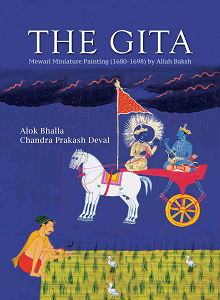
The Gita. Mewari Miniature Painting (1680- 1698) by Allha Baksh
Alok Bhalla and Chandra Prakash Deval, Niyogi Books, 2019 Pages 484.
K.P.Shankaran
TO a cursory reader Alok Bhalla and Chandra Prakash Deval’s The Gita could well pass off as a coffee table book of Mewari Miniature Painting. The effect created by the glossy paper and outstanding paintings by Allah Baksh with slokas from the Gita ensconced within them – can in itself inspire a conversation . But to the discerning reader, the book has much more to offer.
Bhalla’s introduction is concise but very informative. Gita as a text is too well known to require an introduction; so Bhalla takes this opportunity to introduce Allah Baksh and his paintings to the readers. As Bhalla’s commentary demonstrates, Allah’s paintings are a reflection of the philosophical and emotional significance of the slokas of the Gita. As Bhalla tells us, he is also the first illustrator of the Gita.
The book is in fact the story of visualisation of the Gita by a great Muslim illustrator, Allah Baksh. Like all craftsmen, Allah Baksh cannot be expected to be original. As an illustrator he is visualisating the slokas of the Gita within the school of Mewari style. So his freedom of depiction is seriously constrained. He is restricted in the use of colours, space, form.- constraints imposed upon him by the Mewari school of painting. What stands out therefore, is his superb craftsmanship and his insight into the meaning of the slokas. When one reads a sloka and studies Allah Baksh’s illustration of it, the meaning of the sloka acquires a more satisfying significance—that is the magic Alok Bhalla with his commentary helps the reader to appreciate.
Bhalla’s introduction to the chapters of the Gita are brief and philosophically nuanced. Each chapter contains the original shlokas along with their English translation and Allah Baksh’s fabulous illustrations. The commentary by the author is most interesting because it links each sloka with Allah Baksh’s illustration and shows how meticulously the illustrator has tried to portray all the emotional /philosophical tropes in the slokas . In other words it provides a commentary not only on the slokas of the Gita but also on Allah’s illustrations accompanying the slokas.
Bhalla sees the Gita as a philosophical poem rather than as a Shruti text of Hinduism. This allows him the liberty to be critical instead of blindly reverential. He gives, it seems to me, a Gandhian non – hierarchical reading of the sloka in chapter 4 , which says Krishna is the author of Chatur Verna.
The author’s extensive footnoting, including footnotes on phrases borrowed from other sources, does at times hinder a smooth reading of the text. This minor irritant apart, this book is superbly produced as well as unique
In 21st century India, when society is being torn asunder by a deep seated hatred for the Muslims engineered by the current dispensation, the significance of a Muslim craftsman lending his brilliant craftsmanship to a Hindu religious text, should certainly not lost on the reader.
***
[Alllah Baksh, from the book]
![]()
![]()
![]()
![]()
*****
Notes
Many thanks to Alok Bhalla for making available sample illustrations from the book.
K.P. Shankaran was Associate Professor at St. Stephen’s College New Delhi, where he taught Philosophy He also taught Political Philosophy and Gandhian Thought at Delhi University. He has written a book, “Marx and Freud on Religion” and many essays on Gandhi. He is currently working on a book about Brancusi, a Romania-born French sculptor.
K.P. Shankaran in the beacon CRITIQUING CAPITALISM: GANDHI AND MARX MICHELANGELO: CRAFTSMAN OR ARTIST? Gandhi’s Philosophical Way of Life: Some Key Themes Ethical Living, Not Religion: The Buddha’s Solution to Existentialist Crisis

Leave a Reply